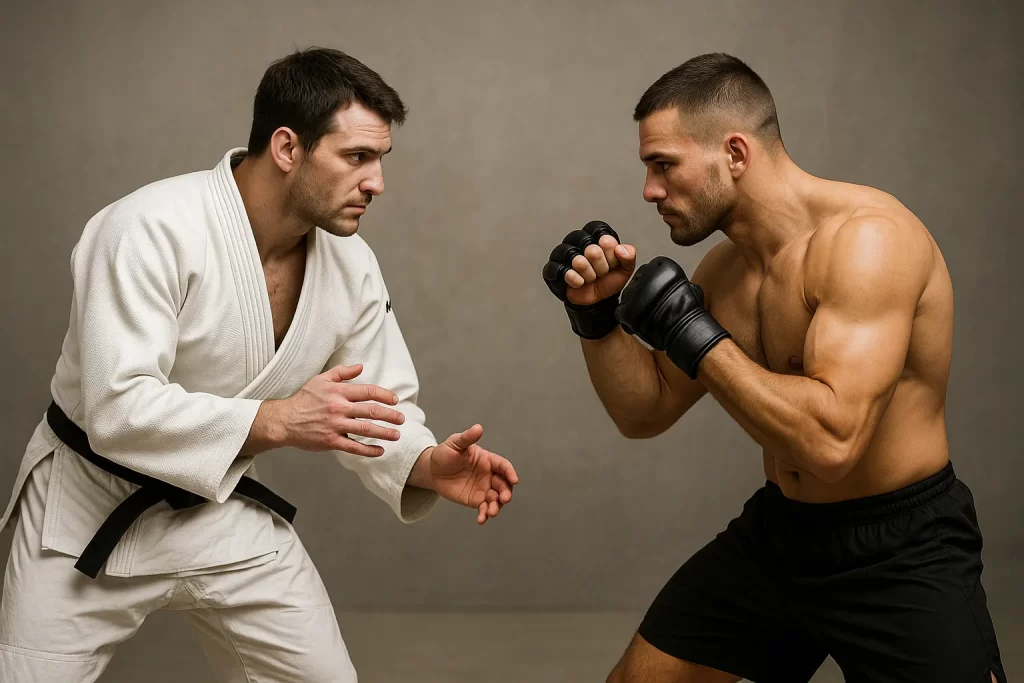The Essence of Judo: Discipline, Leverage, and Subtlety
Foundational Assumptions and Combat Style
Judo, founded by Jigoro Kano in 1882, is rooted in the Japanese samurai traditions of jujutsu. It prioritizes control over direct confrontation, turning the opponent’s energy and momentum against them. The central assumption of Judo is that technique can overcome brute strength—a belief encapsulated in its core principles: Seiryoku Zenyo (maximum efficiency with minimum effort) and Jita Kyoei (mutual welfare and benefit).
In combat, Judo relies heavily on throws (nage-waza), pins (osaekomi-waza), joint locks (kansetsu-waza), and chokes (shime-waza)—all executed primarily from a standing clinch or ground-based grappling position. Striking techniques are not emphasized in modern sport Judo, though they remain part of older kata forms and self-defense applications.
Training Methodology and Practice Culture
Training in Judo is rigorous, structured, and highly codified. Classes generally begin with ukemi (breakfall practice) to prepare for safe falling, followed by technique drilling, randori (sparring), and sometimes kata (formal movement sequences). The environment emphasizes humility, discipline, and respect, often accompanied by traditional etiquette such as bowing and formal greetings.
Judo’s pedagogy is progressive: beginners are gradually introduced to techniques in a controlled manner, ensuring safety and technical accuracy. This makes it accessible for a wide range of ages and body types. Injury risk is lower than in many striking arts, due to the absence of punches and kicks in regular practice.
Philosophical Underpinnings
The philosophical framework of Judo extends beyond the mat. Kano envisioned Judo as a system for moral and physical education, not merely a combat sport. Practitioners are encouraged to cultivate personal discipline, social responsibility, and mutual respect. These values are woven into the teaching methodology and dojo culture.
Practical Relevance in Daily Life
From a practical perspective, Judo offers several direct and indirect benefits:
- Self-defense: its emphasis on balance disruption, throws, and submissions makes it effective in close-quarters confrontations, especially in standing clinches or if taken to the ground.
- Physical conditioning: Judo practitioners develop core strength, agility, flexibility, and cardiovascular endurance.
- Mental resilience: the constant pressure of randori and the need for rapid adaptation build psychological toughness and problem-solving skills.
- Social integration: because of its emphasis on cooperation and mutual development, Judo fosters strong peer relationships and community.
Suitability for Different Practitioners
Judo is well-suited for individuals seeking structured progression, a mix of sport and self-defense, and a deeply philosophical approach to martial arts. It is especially beneficial for:
- Children and adolescents, due to its emphasis on control and safety
- Adults seeking fitness and discipline without striking
- Professionals balancing mental and physical development
The main prerequisite is patience and consistency; mastery in Judo comes slowly and demands years of focused practice.
The Nature of MMA: Versatility, Adaptation, and Real-World Efficiency
Foundational Assumptions and Combat Style
Mixed Martial Arts (MMA) operates under a fundamentally different set of assumptions. Unlike Judo, MMA is not a traditional martial art, but rather a competitive sport built on cross-training and effectiveness. Its premise is that no single style is sufficient for all scenarios. Fighters must integrate striking, wrestling, and grappling into a seamless whole.
In combat, MMA is characterized by its fluid transitions between ranges—stand-up striking (boxing, kickboxing, Muay Thai), clinch (Greco-Roman, dirty boxing, judo throws), and ground fighting (Brazilian jiu-jitsu, wrestling, ground-and-pound). It emphasizes both offensive and defensive adaptability, with success hinging on a fighter’s ability to blend techniques in dynamic, unpredictable situations.
Training Methodology and Practice Culture
Training for MMA is multidisciplinary and performance-driven. Athletes typically divide their time between:
- Striking classes (boxing, Muay Thai)
- Grappling sessions (wrestling, BJJ, sometimes Judo or Sambo)
- Conditioning and strength training
- Sparring and situational drills across multiple contexts
The environment is pragmatic, competitive, and often oriented toward fight preparation. Less emphasis is placed on tradition or ritual—though discipline and respect still play a key role in high-level gyms.
Philosophical Underpinnings
MMA lacks a unified philosophical doctrine. Its implicit philosophy is efficiency through adaptation, often expressed in the maxim: “Whatever works, use it.” Fighters and coaches may borrow mental frameworks from individual styles (like Zen from Karate or warrior ethos from wrestling), but the overarching ethos is outcome-focused and utilitarian.
This makes MMA highly attractive to pragmatists, but potentially alienating to those seeking a deep-rooted cultural or spiritual component.
Practical Relevance in Daily Life
In terms of real-world application, MMA offers:
- Self-defense versatility: its breadth of techniques allows for responses to various threat types, whether standing or grounded.
- Elite physical fitness: training at an MMA gym develops power, endurance, speed, and coordination.
- Stress inoculation: MMA’s intensity teaches individuals to remain composed under pressure, both physically and psychologically.
- Confidence and assertiveness: surviving sparring and competition cultivates a strong internal sense of capability.
Suitability for Different Practitioners
MMA is ideal for those who:
- Desire maximum fighting effectiveness in real-world or competitive settings
- Have prior experience in one or more martial arts and want to expand
- Enjoy high-intensity, full-contact environments
However, it is physically demanding and less suited for absolute beginners without strong supervision. Its broad scope requires commitment to multidisciplinary learning and physical resilience.
Controlled Environments: Dojo, Gym, and Competition
Judo in Structured Training and Competition
In a dojo or sport setting, Judo’s highly formalized ruleset fosters technical precision, mutual safety, and mental discipline. Techniques are executed under strict guidelines—illegal moves include strikes, certain joint manipulations, and attacks below the belt.
Judo tournaments (shiai) reward throws with control and impact (ippon), as well as pins, armlocks, and chokes on the ground. The sport’s infrastructure is well-regulated by international federations (e.g., IJF), making it especially accessible to youth and those new to martial arts.
Key example:
- Osoto Gari (major outer reap) – uses timing and balance disruption, ideal for safe projection in a controlled space.
- Kesa Gatame (scarf hold) – effective for ground control without inflicting damage.
The structured randori format allows for safe resistance training, promoting skill development through repetition and correction rather than full-contact confrontation.
MMA in Structured Training and Combat Sports
In contrast, MMA training replicates high-pressure combat with fewer technical constraints. While gyms vary, sparring often includes full-contact striking and takedowns, requiring protective gear and strong supervision.
Competition follows rulesets from organizations like UFC or Bellator, allowing punches, kicks, elbows, knees, takedowns, ground strikes, and submissions. Fighters must train across multiple ranges and disciplines, preparing them for diverse scenarios.
Key example:
- Double-leg takedown (from wrestling) – explosively closes distance; vulnerable to guillotines or knees.
- Ground-and-pound from mount – combines position control with striking, absent from Judo.
While more chaotic, MMA fosters rapid decision-making and resilience under stress—ideal for simulating the unpredictability of real combat. However, it demands high physical conditioning and injury tolerance, limiting accessibility for some populations.

Real-Life Scenarios: Self-Defense and Daily Application
Judo in Real-World Contexts
Judo’s strength lies in close-quarters self-defense. In confined or urban environments—public transport, crowded events, hallways—it excels due to its clinch control and standing grappling. Its techniques don’t rely on striking, which can legally and ethically complicate civilian altercations.
Practical scenario:
- A push or grab in a parking lot is defused using Tai Otoshi (body drop), subduing without escalation.
- A rear bear hug can be countered using Ura Nage (rear throw) or breaking balance with hip movement.
Moreover, its non-violent image may be more socially acceptable in civilian conflicts, and easier to justify in legal contexts where excessive force is scrutinized.
MMA in Real-World Contexts
MMA is often viewed as the gold standard for self-defense due to its versatility. It covers a broader spectrum—punches, kicks, takedowns, submissions, and escape strategies—making it well-suited for surprise attacks or encounters with armed or multiple attackers (if properly trained).
Practical scenario:
- In a street assault, an MMA-trained individual might use a leg kick to disable, then clinch to takedown, transitioning into dominant control or escape.
- Against a punch, head movement into a clinch and trip enables immediate neutralization.
However, the use of striking raises the risk of legal or ethical repercussions, and some techniques may require greater force, potentially leading to escalation. Moreover, real-life conditions (hard ground, multiple attackers) complicate some ground-based strategies.
Technique Comparisons and Their Implications
| Technique | Judo Version | MMA Counterpart | Key Difference |
|---|---|---|---|
| Standing Control | Kumi-kata (grip fighting) | Clinch with underhooks | Judo emphasizes balance; MMA adds strikes/knees |
| Takedown | Uchi Mata (inner thigh throw) | Single/double-leg shot | Judo uses leverage and timing; MMA often uses explosiveness |
| Ground Control | Yoko Shiho Gatame (side control) | Side control with strikes | Judo maintains position; MMA attacks from position |
| Finishing Hold | Juji Gatame (armbar) | Armbar or rear-naked choke | Both use submissions, but MMA often transitions from strikes |
| Defense | Off-balancing (kuzushi) | Footwork, sprawl, guard pulls | Judo neutralizes; MMA disperses or counters |
Each system excels in different parameters: Judo is elegant and effective for control, while MMA is broader but more force-reliant. A blend of both can be synergistic.
Age Suitability: Who Should Train What, and Why?
Children and Adolescents
- Judo is ideal for children due to its non-striking nature, structured hierarchy, and strong emphasis on safety and etiquette. It teaches falling safely (ukemi), cooperation, and physical coordination.
- MMA for kids exists, but is often limited to technique drilling or non-contact formats due to higher risk and psychological stress in full-contact scenarios.
Young Adults (18–35)
- MMA is best suited to this group, which can handle intense training volume, injury risk, and competitive environments. This is the peak window for competition and rapid athletic development.
- Judo is also excellent, especially for those seeking Olympic competition or deep skill development. However, it offers less breadth for real-world fighting unless supplemented.
Adults 35+
- Judo remains accessible, especially in clubs focusing on kata or recreational randori. Its pace can be adjusted and injury risk managed with proper instruction.
- MMA becomes more challenging, especially for late starters. While fundamentals can still be learned, sparring and live scenarios require caution, recovery time increases, and injury risks mount. Some do participate successfully, but the training must be highly personalized.
Seniors and Returnees
- Judo kata or modified randori can be suitable for older practitioners looking for movement, discipline, and philosophical depth.
- MMA is generally not recommended without significant prior experience or extreme adaptations.
Conclusion: Complementary Strengths, Distinct Realities
Judo and MMA serve different yet overlapping needs. Where Judo offers safety, structure, and philosophy-driven development, MMA delivers versatility, realism, and combat-ready skills. Neither is inherently superior—only more or less appropriate depending on context, goals, and individual capacity.


